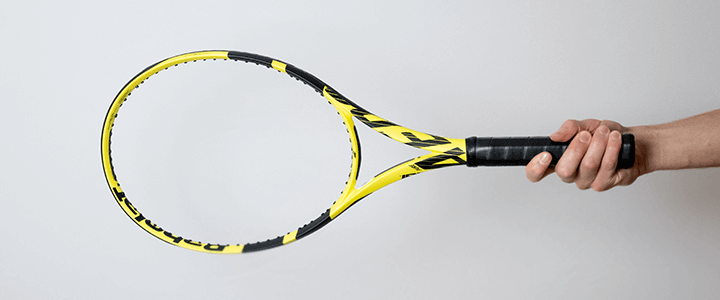Check out my custom vibration dampener
A Complete Overview of The Semi-Western Forehand Grip
With a Helpful Diagram
The semi-western grip is one of three primary tennis grips used to hold a tennis racquet when hitting a forehand. While there is no perfect grip, the semi-western grip has become one of the most popular forehand grips in tennis.
In this article, we’ll explore the semi-western grip as well as the pros and cons associated with it.
Article Contents
Click below to jump to a section
Tap below to jump to a section
Semi-Western Grip
Holding a Semi-Western Grip
Benefits
Drawbacks
Using the Semi-Western Grip
Wrapping Up
New to TennisCompanion?
Create a free account and explore my latest videos below
The Semi-Western Tennis Grip

It wasn’t all that long ago when the continental tennis grip was the primary grip used by tennis players for all strokes.
At the time, the continental grip was convenient. However, as racquet and ball technology evolved and the sport became more competitive, the use of the continental forehand grip quickly became a thing of the past.
Through the evolution and increased competitiveness of the game, the semi-western grip was born, allowing players to hit highly aggressive shots with a significantly higher margin for error.
Now, years later, the semi-western grip has become one of the most popular tennis grips, and professional tennis players around the world use it.
Holding a Semi-Western Grip

To form a semi-western forehand grip, we’ll first take a look at the racquet handle to guide the position of our hand. You may have noticed that the handle of a racquet isn’t a perfect cylinder or smooth around the edge of the handle.
Instead, the handle of a tennis racquet forms roughly the shape of an octagon, with eight sides. This design allows players to grip the racquet better and prevent it from slipping while hitting, but it also provides a great reference point when learning various grips.
In the diagram below, we’ve labeled each side, or bevel, of the racquet handle. To form the semi-western grip, we place the palm side of our index finger’s knuckle against the fourth bevel if you’re right-handed, or the sixth bevel if you are left-handed.

For many beginners, the semi-western tennis grip might feel awkward at first. That’s fairly natural, so don’t worry if that’s the case for you. However, it’s worth sharing how things feel with your instructor, as there are other grips, such as the less extreme eastern grip, that may feel more comfortable to start with depending on the player.
Generally, most players will be taught one grip – either the eastern or semi-western – and then slowly progress to a grip that suits them and feels comfortable.
Benefits of the Semi-Western Grip

The primary benefit of the semi-western grip is a player’s ability to generate topspin. With the continental grip, the face of the racquet was rather neutral – that is, if you held the racquet out in front of you, the frame would line up perpendicular to the ground.
However, with a semi-western grip, the angle of the racquet face is closed or pointing toward the ground. As a result, when you swing and come in contact with the ball, you can easily brush up and over the top of a tennis ball to produce topspin.
Players using a semi-western grip can hit the ball higher over the net and ensure the ball drops back into the court due to the topspin generated. Ultimately, this allows players to hit much more aggressively and with a higher margin for error.
Drawbacks of the Semi-Western Grip

While the semi-western grip is an extremely common grip for tennis players, there are two potential drawbacks to using it.
First, it can sometimes be challenging for players to transition quickly from a forehand to a volley. For example, if you were to step into the court to hit a forehand approach shot, and then continue forward to hit a volley, you’d need to quickly rotate the racquet handle in your hand as you performed a split step and moved forward.
For most players, this may come as a challenge early on. However, through practice, it’s a relatively easy drawback to overcome.
In addition, it can be challenging for players to hit an extremely low ball that’s only a few inches from the ground, because the semi-western grip forces a player to hit under and over the ball to generate topspin.
Again, over time, this typically becomes less of a concern as most players will feel comfortable hitting a low ball or simply adjusting their grip for that particular shot.
Should I Use the Semi-Western Grip?
Unfortunately, there isn’t a simple answer to this question. Everyone is built differently, so each forehand grip will feel different for every player.
However, the semi-western grip can be a great starting point for many players – it’s not overly extreme or too conservative. With that said, most players will need to experiment with the eastern, semi-western, and western grips to get a sense for what feels comfortable.
It can also be helpful to recognize that for many players, it can take some time to grow into the grip that works best. The key is to be flexible. If you have the opportunity to spend time working with a tennis instructor, they can help you work through the process.
Wrapping Up
Have questions about the semi-western tennis grip? Feel free to ask us in the comments below.
Photo Credit: 28 DIAS
Home > Instruction > Forehand > Semi-Western Forehand Grip
Play Better Tennis
Improve your game alongside our community of tennis players
Why join?
Discussion Boards
Join the conversation with other members of the community.
5 Point Friday
Read our weekly recap of the 5 most interesting things we dig up in tennis.
Trackbacks & Pingbacks
Leave a Reply
Want to join the discussion?Feel free to contribute!



I have used the continental grip for over 15 years. Now Iwant to add more power and spin to my strokes. Is it difficult to learn the semi Western? Any experiences from other players?
Hey Hein,
Great question! The quick answer is yes, it can be challenging for a player to move from one grip to another. In your case moving from a continental grip to a semi-western grip will feel like a pretty extreme shift, however if you’re committed to changing it’s worth the effort.
Here are a few suggestions to help in the change:
Hopefully that helps, but please feel free to follow up with any additional questions you might have. If you decide to move forward with the change, good luck!
All the best,
Jon
No it is easy to learn best grip for forehand power and consistency